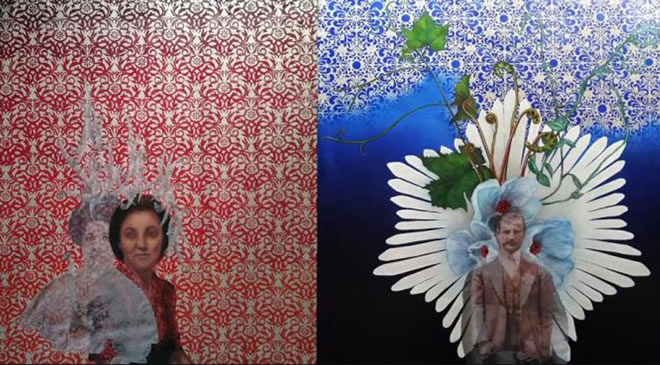
By Alicia Eler Star Tribune
Wednesday December 18, 2019

Are you qualified to sit in Somali-American artist Ifrah Mansour's dazzling golden power chair, adorned with flowers from every color of the rainbow?
It's in the corner at Soo Visual Arts Center (SooVAC), offering a seat to those who identify as people of color. Across from the chair, a mesmerizing video diptych shows people sitting in the chair at the 2019 Little Africa Festival in St. Paul — being told they are the most powerful people on the planet, and embracing that idea.
Minneapolis-based Mansour is one of 24 artists of SWANA (Southwest Asian and North African) descent featured in the group exhibition "Let There Be Spaces in Your Togetherness," organized by the St. Paul-based Arab cultural organization Mizna. The title of the show is taken from a quote by Lebanese-American poet Kahlil Gibran, offering a sense of community.
SWANA is meant as a corrective to "Middle East," a Western, colonialist term. Defining the region along geographic rather than political lines, its borders stretch from Morocco in the west to Afghanistan in the east, embracing a broader swath of countries, including Somalia.
That definition attracted artists such as Mansour, who would not have been included in a "Middle Eastern" show. Mizna, which also curated the recent show "History Is Not Here: Art and the Arab Imaginary" at the Minnesota Museum of American Art, even views the term "Arab" as "limiting and imperfect." Not all of the artists in that show identified as Arab.
"We were having conversations almost weekly about how do we define ourselves and our region without becoming exclusionary, and also taking into account Arabs' own colonial history in Africa and with Kurdish communities," said Palestinian-American artist Lamia Abukhadra, whose work is in the show and also served as a juror for it.
"It is still an ongoing and difficult conversation — the idea of regions and cartography. All these things are based in colonialism."
'Come to my world'
"Let There Be Spaces in Your Togetherness" is a start. The juried exhibition, which continues through Jan. 9, takes over both galleries at SooVAC with paintings, video, sculpture, installations and more.
Ten of the 24 artists are based in the Twin Cities, with the rest coming from Chicago, Michigan, California and elsewhere. All either hail from or have family members from Syria, Palestine, Saudi Arabia, Egypt, Somalia, Iran, Afghanistan, Iraq, Lebanon and Mauritania.
"Upon My Daughter," a 6½-minute video by Los Angeles-based, Kabul-born Gazelle Samizay, is an intimate portrait of women embroidering a young bride's wedding dress while she rests on her back. The women sew together the feminine and familial bonds of this dress; each stitch symbolizes a piece of advice.
Another striking work is Detroit-based Noura Ballout's black-and-white photo "Mama's Boy," a waist-down shot of the artist's hairy belly and boxer briefs from a series titled "On Gender." Ballout, who emigrated from Beirut to Detroit and Dearborn, began taking self-portraits as a way to investigate genderqueer identity.
Arab-American Minneapolis-based artist Hend Al-Mansour, who grew up in Saudi Arabia, is one of the show's three jurors. She noticed an emotional thread among those artists who immigrated to the United States.
Most are "torn between two things," she said. "We want to be part of America very much — this is a very dear wish — but at the same time we want to keep our identity as people wherever we came from, where we were born."
Her projected animation "Bia" uggests this feeling of dealing with assimilation. A young girl approaches a giant door (actually the door to Al-Mansour's mother's house), and enters, falling into a magical animated world filled with a wheel of spinning feminine archetypes.
A super-pious, praying woman in a full-length hijab surrounded by a fire halo pops up. A shepherdess — a common figure in Saudi culture — watches over lambs. A woman walks with her daughter. A sugar doll with many arms, popular in Egypt during the week of the prophet Mohammed's birthday, twirls about. The young girl witnesses them all.
"I want people to come to my world from an artistic perspective," said Al-Mansour. "The images are all spontaneous — they come from my memory, my history, my own culture."
"Let There Be Spaces" will tour with a selection of films from Mizna's Arab Film Fest to St. Cloud State University, opening Jan. 22 at the Kiehle Visual Arts Center, and then the New York Mills Cultural Center at a still-unannounced date.
Alicia Eler is the Star Tribune's visual art critic/arts reporter. She is the author of the book “The Selfie Generation” (Skyhorse Publishing), which has been reviewed in the New York Times, WIRED Magazine and the Chicago Tribune.